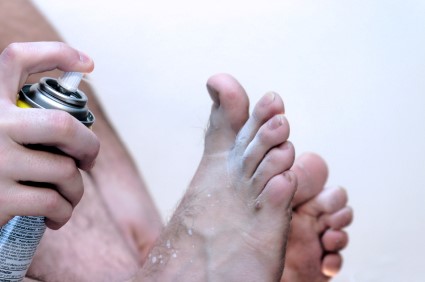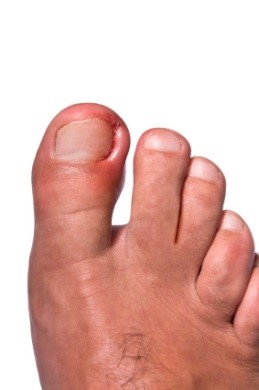September 2014
Homemade Athlete’s Foot Remedies
 Patients who would rather not have anything to do with prescription drugs can make use of natural remedies to successfully treat Athlete’s foot. For example, be sure to apply apple cider vinegar or tea tree oil directly onto areas of the foot affected by the condition.
Patients who would rather not have anything to do with prescription drugs can make use of natural remedies to successfully treat Athlete’s foot. For example, be sure to apply apple cider vinegar or tea tree oil directly onto areas of the foot affected by the condition.
There are also a number of liquid solutions that can be made to wash the feet in. For one solution, mix one part white vinegar with two parts warm water, soaking the feet can soak for fifteen minutes. You can also grind garlic into a fine paste and mix into a tub of water to create another solution. A third solution is boiling neem leaves in water for ten minutes, allow water to cool, and wash the feet in this twice a day.
Athlete’s foot can be treated with either prescription drugs or natural remedies like those aforementioned. Consult with podiatrist Dr. Genine Befumo of University Foot & Ankle Center. Dr. Befumo will attend to all of your foot and ankle needs.
Athlete’s Foot: The Sole Story
If you suffer from itching, burning, dry, and flaking feet, this may be a sign of athlete's foot. Athlete's foot, also known as tinea pedis, can be extremely contagious, and it often infects shower floors, gyms, socks and shoes, and anywhere else feet may come in contact with. It is commonly found in public changing areas and bathrooms, dormitory style living quarters, around locker rooms and public swimming pools.
Solutions to Combat Athlete’s Foot
- Hydrate your feet by using lotion
- Exfoliate
- Buff off nails
- Use of anti-fungal product
- Examine feet and visit your doctor if any suspicious blisters or cuts are present.
What is Tinea?
- Athlete’s foot is often caused by the same fungus that causes ringworm (tinea).
- Tinea can invade other parts of the body as well, if the proper thriving conditions for it are met.
- Tinea thrives in mostly dark, warm and moist environments.
- Although many people never experience athlete’s foot, around 70% of the population may suffer from tinea at some point.
For more information about Athlete’s Foot, follow the link below.
If you have any questions, please contact one of our offices in East Brunswick and Monroe, NJ. We offer the newest diagnostic and treatment technologies for all your foot care needs.
Read more about Athlete’s Foot
Ingrown Toenails Can Occur in Children
 Children are susceptible in developing ingrown toenails in their feet for a myriad of reasons. One of the main ways a child can get an ingrown toenail is by cutting his or her nails too short. To prevent such an occurrence, cut their nails evenly and be sure not to trim them down too much. Ingrown nails may also occur if a child wears socks and shoes that do not adequately cover his or her feet.
Children are susceptible in developing ingrown toenails in their feet for a myriad of reasons. One of the main ways a child can get an ingrown toenail is by cutting his or her nails too short. To prevent such an occurrence, cut their nails evenly and be sure not to trim them down too much. Ingrown nails may also occur if a child wears socks and shoes that do not adequately cover his or her feet.
Other cases of ingrown toenails can simply be caused by a genetic predisposition to curved nails. No matter how the ingrown toenail was caused, do not attempt to treat this condition at home. Removing an ingrown nail with a “bathroom surgery” can lead to a bacterial infection.
Ingrown toenails are terribly uncomfortable, and in the worst cases surgery might be required to get rid of them. If you think you have an ingrown toenail, consult podiatrist Dr. Genine Befumo of University Foot & Ankle Center. Dr. Befumo will confirm your diagnosis and do everything she can to treat your problem.
Ingrown Toenails Causes
Ingrown toenails occur when a toenail grows sideways into the bed of the nail, causing pain, swelling, and possibly infection.
There are a number of risk factors for ingrown toenails. Some include cutting your nails too short, participating in strenuous sports, diabetes, obesity, and fungal infection. Some are genetically predisposed to ingrown nails, although wearing ill-fitting or damp shoes can exacerbate the problem.
Treatment
There are a number of steps you can take to treat ingrown nails:
-Let your toenails grow out
-Soak the toes in hot water with antibiotic soap or Epsom salts
-Placing a piece of cotton under the affected nail may allow the toe to grow up instead of into the nail bed
-Rest with your feet up
If however, your pain is severe, or you see red streaks running up your leg, you should see a podiatrist. Your podiatrist may make a small incision and remove part of the toe nail to relieve the pressure. A local anesthetic may be used to lessen the discomfort of the operation. Topical medication may also be prescribed to prevent the regrowth of the problem nail.
If you have any questions, please contact one of our offices in East Brunswick and Monroe, NJ. We offer the newest diagnostic and treatment technologies for all your foot care needs.
Read more about Ingrown Toenails
Scientists Research Role of Foot Muscles
 University of Queensland scientists focused their research efforts and discovered the role foot muscles play in arch support. To prove that it isn’t just the plantar fascia, an experiment involving weights was conducted. The scientists monitored the responses of the muscles in their feet as the subjects moved.
University of Queensland scientists focused their research efforts and discovered the role foot muscles play in arch support. To prove that it isn’t just the plantar fascia, an experiment involving weights was conducted. The scientists monitored the responses of the muscles in their feet as the subjects moved.
Another experiment involving electrical stimulation was performed soon after, which showed that when activated, these tissues cause the arch to rise. Dr. Glen Lichtwark believes this could play an important role in fields focusing on the feet. This includes footwear design, injury rehabilitation, and even the biological understanding of bipedalism.
The biomechanics are the cogs behind the gears that manage your feet. If you would like more information, see podiatrist Dr. Genine Befumo of University Foot & Ankle Center. Dr. Befumo can provide in-depth information as well as measure your personal foot biomechanics.
A History of Biomechanics
- Biomechanics dates back to the BC era in Egypt where evidence of professional foot care has been recorded.
- In 1974 biomechanics gained a higher profile from the studies of Merton Root, who claimed that by changing or controlling the forces between the ankle and the foot, corrections or conditions could be implemented to gain strength and coordination to the area.
Modern technology improvements are based on past theories and therapeutic processes providing a better understanding of podiatry concepts for biomechanics. Computers provide accurate determinations about the forces, moments and patterns of the foot and lower legs with the most important information captured.
Advances in materials and more awareness of biomechanics have developed enhanced corrective methods, offering further options for foot-related injuries. Understanding foot biomechanics can help improve and eliminate pain, stopping further stress to the foot.
If you have any questions, please contact one of our offices in East Brunswick and Monroe, NJ. We offer the newest diagnostic and treatment technologies for all your foot care needs.
Read more about Biomechanics of Podiatry.
Blog Archives
- April 2024
- March 2024
- February 2024
- January 2024
- December 2023
- November 2023
- October 2023
- September 2023
- August 2023
- July 2023
- June 2023
- May 2023
- April 2023
- March 2023
- February 2023
- January 2023
- December 2022
- November 2022
- October 2022
- September 2022
- August 2022
- July 2022
- June 2022
- May 2022
- April 2022
- March 2022
- February 2022
- January 2022
- December 2021
- November 2021
- October 2021
- September 2021
- August 2021
- July 2021
- June 2021
- May 2021
- April 2021
- March 2021
- February 2021
- January 2021
- December 2020
- November 2020
- October 2020
- September 2020
- August 2020
- July 2020
- June 2020
- May 2020
- April 2020
- March 2020
- February 2020
- January 2020
- December 2019
- November 2019
- October 2019
- September 2019
- August 2019
- July 2019
- June 2019
- May 2019
- April 2019
- March 2019
- February 2019
- January 2019
- December 2018
- November 2018
- October 2018
- September 2018
- August 2018
- July 2018
- June 2018
- May 2018
- April 2018
- March 2018
- February 2018
- January 2018
- December 2017
- November 2017
- October 2017
- September 2017
- August 2017
- July 2017
- June 2017
- May 2017
- April 2017
- March 2017
- February 2017
- January 2017
- December 2016
- November 2016
- October 2016
- September 2016
- August 2016
- July 2016
- June 2016
- May 2016
- April 2016
- March 2016
- February 2016
- January 2016
- December 2015
- November 2015
- October 2015
- September 2015
- August 2015
- July 2015
- June 2015
- May 2015
- April 2015
- March 2015
- February 2015
- January 2015
- December 2014
- November 2014
- October 2014
- September 2014
- August 2014
- July 2014




